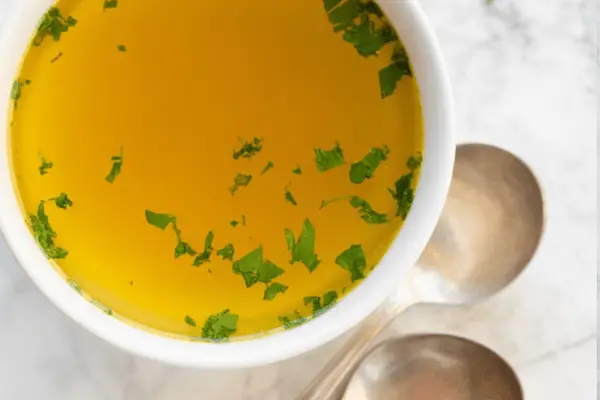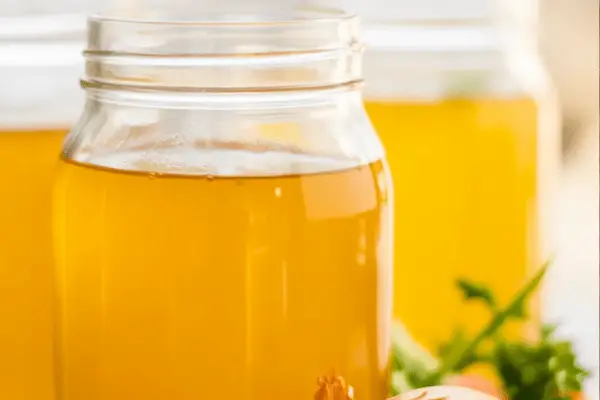Learn how to make the healthiest, most nourishing Chicken Stock with these three simple methods: stovetop, slow cooker, and Instant Pot. This deeply flavorful bone broth has been a staple in my kitchen for years, and I promise you—once you start making your own, you’ll never go back to store-bought.

Why I Love Making Homemade Chicken Stock
There’s nothing quite like a pot of simmering chicken stock filling the house with that warm, savory aroma. I remember when my kids were little, they’d wander into the kitchen asking, “Is it soup day?” even though I’d just be making stock. That smell just makes a home feel cozy.
What I love most is knowing exactly what’s going into it—no weird additives or excess salt, just real ingredients. It’s incredibly versatile. I use it for soups, risottos, gravies, or simply sipping from a mug when I’m feeling under the weather. It’s one of those humble kitchen projects that feels old-fashioned in the best possible way.
Ingredients for Chicken Stock (Chicken Bone Broth)
- 2 1/2 lbs of chicken bones (from 2 chickens), roasted*
- 1 Tbsp cider vinegar
- 1 tsp salt
- 1 medium onion, peeled and halved
- 2 ribs/sticks of celery (cut into thirds, with leaves attached)
- 2 medium carrots, peeled and halved
- 2 smashed garlic cloves
- 1 bay leaf, optional, but nice
- Filtered Water (stockpot: 16 cups, 6Qt Slow Cooker: 12 cups, Instant Pot: 10-11 cups)
About Roasting the Bones:
Whenever I roast a chicken for Sunday dinner, I always save the bones in a bag in the freezer. Over time, I accumulate enough to make stock without even planning for it. Roasting them before adding to the pot adds such an incredible depth—like you’re starting with a head start on flavor. Even if you’re tired at the end of dinner, it’s worth it.

Stovetop Method (15 Hours of Slow Cooking)
If you’ve got a big old stock pot like I do, this is the classic way. I usually do this on a chilly weekend when I’m home anyway. I let it go low and slow, and give it an occasional stir. Yes, you do have to babysit it a little to keep it from boiling too hard, but there’s something so rewarding about tending to it all day.
Pro Tip:
You’ll know it’s done when you can snap the bones easily. That’s when all that good marrow has melted into your broth. Don’t worry if it’s jelly-like when cold—that’s perfect. It means you’ve extracted all that glorious gelatin.
When my kids see the stock firm up in the fridge, they think it’s magic. It’s actually the sign of a properly made, nutrient-rich broth.
Slow Cooker Method (15 Hours on Low Heat)
This is my go-to when I don’t want to think about it. I often set it up in the evening before bed. I pour in warm water (it heats faster), set it to low, and wake up to a house that smells like a country kitchen. It’s seriously one of the most comforting ways to start the day.
I like this method because there’s no risk of it boiling too hard and clouding up. It’s gentle and consistent. I’ll often make a double batch and freeze it in quart containers so I’m stocked for soups all winter.

Instant Pot Chicken Bone Broth (2 Hours)
If you’re impatient like me sometimes, this method is a lifesaver. I didn’t expect to love it as much as I do. I was skeptical about whether it would have the same depth of flavor, but the Instant Pot really surprised me.
I use this method when I’m pressed for time during a busy work week. Two hours and it’s done. Plus, there’s almost no skimming. Just set it and forget it. I usually ladle it into jars and keep them in the fridge for sipping. It’s my go-to when I feel a cold coming on.
How to Strain and Store Chicken Stock
Once it’s cooked, I pour it through a fine mesh strainer. I’m not shy about pressing on the solids to get every last drop. That’s the good stuff.
After it cools a bit, I pop it in the fridge overnight. The next morning, I scrape off the hardened fat (I actually save it sometimes for roasting vegetables—it’s so flavorful).
If I’m freezing it, I always leave an inch or so of headroom in the container. I learned the hard way once with a cracked jar in the freezer. Now I use old yogurt tubs or wide-mouth mason jars with plenty of space for expansion.
Serving Suggestions
Homemade chicken stock is the secret to making ordinary dishes taste restaurant-quality. I use it for:
- Chicken noodle soup on sick days (the kids swear it cures anything)
- Rich gravies at Thanksgiving
- Cooking rice or grains with extra flavor
- Deglazing a pan after searing meat
- Even just sipping from a mug with salt, pepper, and fresh herbs
I love to sprinkle in chopped parsley or a squeeze of lemon juice for brightness when drinking it plain.
Storage Tips
- Fridge: Up to 5 days. I like to keep a jar front and center so I remember to use it.
- Freezer: Up to 3 months. I portion it out for easy thawing.
I always recommend labeling your containers with the date. Homemade stock is so good you’ll go through it faster than you expect.
Chicken Bone Broth

How to make nutrient-rich, flavorful chicken stock (bone broth) using an Instant Pot, slow cooker, or stovetop. Homemade chicken bone broth can be used in a variety of recipes.
Ingredients
- 2 1/2 lbs chicken bones, from 2 roasted chickens
- 1 Tbsp cider vinegar
- 1 tsp salt
- 1 medium onion, peeled and halved
- 2 celery ribs, cut into thirds, leaves attached
- 2 carrots, peeled and halved
- 2 garlic cloves, smashed
- 1 bay leaf (optional)
Filtered water:
- Stock Pot: 16 cups
- 6Qt Slow Cooker: 12 cups
- Instant Pot: 10–11 cups
Instructions
Roast the Bones (for all methods):
If using bones from a cooked chicken or turkey, skip this step. Place bones on a lined, rimmed baking sheet and roast at 400°F for 20 minutes.
Stovetop Method (15 hours simmering):
- Place roasted bones and any accumulated juices into an 8 qt stock pot.
- Add 16 cups filtered water, 1 Tbsp cider vinegar, and 1 tsp salt.
- Bring to a boil, then reduce heat to simmer. Skim off impurities from the surface.
- Cover and simmer on low heat for 6 hours.
- Add onion, celery, carrots, garlic, and bay leaf.
- Continue simmering another 9 hours (total of 15 hours).
- If needed, turn off overnight and resume simmering the next day. Avoid a hard boil to prevent cloudiness.
Slow Cooker Method (15 hours on low):
- Place roasted bones and juices into a 6 Qt slow cooker.
- Add 12 cups warm or hot water, 1 Tbsp cider vinegar, and 1 tsp salt.
- Set to low heat for 15 hours.
- After 6 hours, add onion, celery, carrots, garlic, and bay leaf.
- Continue on low heat for 9 more hours.
- You may allow it to cook overnight and strain the following day.
Instant Pot Method (2 hours pressure cooked):
- Place roasted bones and juices into a 6 Qt Instant Pot.
- Add onion, celery, carrots, garlic, bay leaf, cider vinegar, and salt.
- Add 10–11 cups water (up to the 2/3 max fill line).
- Select “Soup/Broth” and set time for 2 hours (120 minutes).
- After cooking, allow 30 minutes for natural pressure release, then manually release the rest (use oven mitts for safety).
How to Strain and Store Chicken Stock:
- Strain through a fine mesh sieve into a second pot, pressing to extract as much liquid as possible.
- Discard solids.
- Cool to room temperature, then refrigerate.
- Once chilled, skim off fat from the top.
- Store in the fridge for 3–5 days or freeze in suitable containers for up to 3 months (leave room for expansion when freezing).
Nutrition Information
Yield
8Serving Size
1Amount Per Serving Calories 545Total Fat 27gSaturated Fat 8gTrans Fat 0gUnsaturated Fat 17gCholesterol 164mgSodium 1109mgCarbohydrates 20gFiber 1gSugar 9gProtein 52g
Dinnerfocus.com, occasionally offers nutritional information for recipes contained on this site. This information is provided as a courtesy and is an estimate only. This information comes from online calculators. Although allchickenrecipes.com attempts to provide accurate nutritional information, these figures are only estimates.
My Final Thoughts
There’s something deeply satisfying about making your own chicken stock. It’s a small act of self-care that pays you back over and over. Whether you simmer it all day on the stove, let the slow cooker do the work overnight, or crank it out in a couple of hours with the Instant Pot, you’re left with a pot of liquid gold.
I hope this inspires you to try making it at home. Once you do, you’ll wonder why you ever bought the boxed stuff.
Try other recipes:
